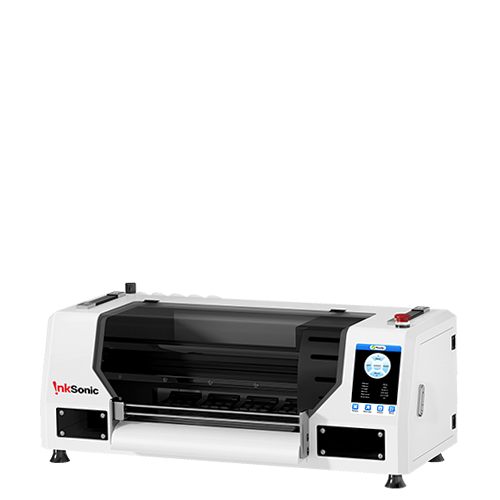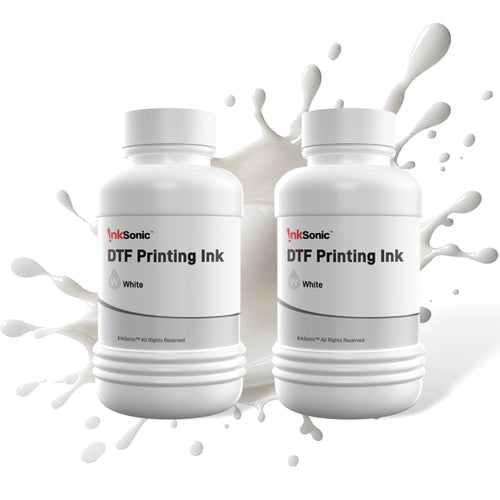When you first enter the DTF printing universe, you have your shiny new printer, colorful designs at your fingertips, and expectation of printing personalized T-shirts, hoodies, or tote bags straight from your home. But a few weeks later, you might notice the following: your white ink runs out much faster than the remainder of the colors.
If you’ve paused to wonder, “Why is my white ink disappearing so quickly?” or “Is this normal?” — you’re not alone at all. Nearly every new DTF user asks this question sooner or later.
It's not a color like any other — it's the foundation that helps all color pop, especially on dark or colored shirts.
But white ink is not only used up quickly, it is also notorious for clogging up the nozzles if you don't properly maintain your printer. This may be intimidating at first, but do not worry.
In this blog, we're going to guide you through exactly why white ink runs out the fastest, why it's most likely to clog, and most importantly, what you can do to keep your prints vibrant and your printer in prime working condition — even if you're a novice.

What Is White Ink & Why It’s Essential in DTF Printing
Unlike regular CMYK inks (cyan, magenta, yellow, and black), white ink plays a unique and crucial role. It isn’t “just another color” — it’s really the foundation of the entire printing process, especially when you’re printing on dark or colored fabrics. In DTF printing, white ink isn’t only used for the visible white parts of your design. Instead, it’s typically printed as an underbase layer that sits beneath all the other colors.
Printing straight on fabric can leave graphics patchy or colors uneven. Adding a white base layer helps fix this by blocking the garment color. Color inks alone can’t fully hide the fabric, but white ink can cover it without color bleed or mix-ups.
The magic of white ink is hidden in a special ingredient: titanium dioxide. This is a white pigment which is known for its brilliance and high opacity. Due to the fact that titanium dioxide is very heavy and dense, white ink can cover up dark surfaces completely, concealing the garment color underneath, makes your colors appear as brighter, richer, and more vibrant on any kind of fabric.

Think of it like a fresh coat of white primer on a wall before painting with color paints — it offers an even, opaque background which causes every color set upon it to look more vivid and specific. Without this base, your CMYK inks would be dull and transparent, and the printed end product wouldn't have that professional, high-contrast look that clients love.
White ink’s role goes beyond just brightness. It also adds durability to your prints. That solid white foundation helps inks stick better to the film and fabric, resulting in prints that last longer through washes and daily wear. Without white ink, the DTF TPU powder cannot adhere and the pattern cannot be transferred to the fabric.

The layer of white ink helps the entire design maintain its shape, color accuracy, and sharpness — and that’s why every serious DTF setup depends on it so heavily. Because of its special role as an underbase layer covering large areas, white ink is almost always consumed the fastest. That’s why it’s perfectly normal to find yourself restocking white ink more often than your color inks.
Why White Ink Easily Clogs the Nozzle
Now that we understand why white ink is used so heavily in DTF printing, it’s equally important to know why it can be such a troublemaker when it comes to clogging.
Many newcomers find this out the hard way: after only a few days of not printing, the nozzle starts to misfire, or even clog completely. But why is this the case, and why are white ink nozzles in printers more prone to clogging than CMYK-only printers?
The primary cause white ink is different is due to its primary ingredient: titanium dioxide (TiO₂). These pigment particles contribute the whiteness of white ink but are much heavier and larger than those used in CMYK inks. Because they are heavy and large, they settle immediately at the bottom of ink bottles, cartridges, and printhead dampers—particularly when the printer is not used for an extended period.

Another big reason is viscosity. White ink is thicker than standard CMYK inks by nature. To illustrate, normal CMYK inks are around 2–3 mPa·s viscosity, while white ink is typically 4–6 mPa·s or even higher depending on the firm and recipe. This increased thickness is what enables it to produce a heavy, opaque underbase on dark colors — but makes it harder to flow easily through the extremely narrow passages and orifices within the printhead.
It is not necessary but a minute amount of dried ink or stratified color to partially clog these microscopic conduits, which then result in printing defects like banding, missing lines, or worst of all, complete clogs which prohibit printing altogether.
Environmental factors around your workspace can make nozzle clogging happen even faster than you’d expect. Working space conditions such as direct sunlight, unusual room temperature, and the presence of fans near the printer can cause the white ink at the nozzle tip to dry quickly. This leaves thick, sticky residue that hardens and clogs nozzles, causing print issues like missing lines or uneven colors.This is one of the reasons why we emphasize the humidity and temperature of the printer room environment.
Moreover, having your printer sit idle for a long period worsens the problem. When your printer is idle, the heavy white ink particles drop down and collect in the printhead and ink lines. Over time, this sediment becomes solid and clogs up, clogging the nozzles during printing.
How to Prevent White Ink Clogging & Reduce Maintenance
You’ve just started your DTF printing business, and after a few busy days, you notice your prints are showing streaks or missing spots — it’s frustrating and really slows you down. Many new users worry about this happening from the start, afraid it could hurt orders or damage customer trust.
Thankfully, there are doable solutions to reduce these issues and maintain the consistency of your prints. Knowing the reason why white ink clogs is the key to making your printer function efficiently. White ink won't disrupt meeting deadlines or growing your business with some simple daily practices and proper care.
Start with daily and routine steps.
Every day, even when you’re not working on big orders, it helps to print a small white test strip. This keeps white ink circulating so the heavy pigment doesn’t settle in the nozzles or ink lines. Running regular nozzle checks and using your printer’s built-in auto-cleaning functions are also quick but powerful habits. They help catch small clogs early, saving you the headache of bigger blockages later.
Add extra protection with accessories.
If your printer will be idle for several days — like during holidays or slower weeks — an external nozzle moisturizing device (also called a capping station humidifier) is a smart addition. It keeps the print head moist, preventing dried ink buildup that’s stubborn and difficult to remove. If you don't know how to use this device, please refer to this video .
The print head is also a supply part.
A study by Digital Graphics Magazine found that 80% of DTF printer malfunctions are related to printhead issues, often caused by ink sedimentation, improper cleaning, or failure to replace aging nozzles. Once nozzles degrade, users experience banding, missing lines, color shifts, and eventually, full print failure, costing both time and materials.
Most new users fail to do this, but printer nozzles do wear out with usage over time, especially when white ink is being printed, as this is heavier and thicker than color ink. Replacing the print head generally keeps your printer in peak working order and ensures print quality.
By everyday routines, choosing the right printer, with protective accessories included, and remembering that nozzles need to be replaced on a regular basis, you can have your white ink running — and your business operating with a whole lot fewer hiccups.
Advanced Tips for Managing DTF White Ink
Once you’ve got the basics down — daily nozzle checks, gentle shaking, and the right printer setup — these extra tips can help keep your prints vibrant and your workflow smooth:
Store White Ink Properly
Keep bottles in a cool, dry place, away from direct sunlight and temperature swings. Always close bottles tightly to keep dust and moisture out.
Recommended temperature range:
20°C to 28°C (68°F to 82°F)
Relative humidity (RH):
40% to 60% (avoid too dry or too humid)
Shake Gently, Not Aggressively
Shake white ink daily, but don’t go overboard. A slow roll or gentle swirl keeps pigments suspended without adding air bubbles that can cause pinholes or banding.
Keep Your Workspace Clean
Clogs or fuzzy prints may result from dust and lint near your printer adhering to wet ink or being drawn into the printhead. Keep the printer away from open windows and blowing fans, and clean surfaces frequently.
Notice Expiration Dates
White ink has a shorter shelf life because of its heavy titanium dioxide pigments. Using old ink increases sediment buildup and clog risk. Please use the white ink within the shelf life and use it up as soon as possible after opening.
Use Correct RIP Settings and ICC Profiles
A balanced white underbase is key: too thick, and prints can feel heavy or crack; too thin, and colors look dull. Matching ICC profiles and proper RIP settings help you get it right.
Learn Early Warning Signs
Small gaps in nozzle checks, banding, or ink spitting at print start often mean a clog is forming. Fix early with cleaning instead of waiting for a complete block.


Choosing Quality Inks and Printers
At this stage, you would have understood how white ink is required but challenging to use in DTF printing. Yet, other than daily maintenance and machine care, there is yet another gigantic factor that plays a massive role in the long run: printer and ink quality.
All white inks are not created equal. Low-quality white inks use cheaper or larger particle pigments that settle faster and clog more readily. Without stabilizers, white ink becomes much harder to handle, causing clogs, wasted prints, and more downtime.
That is why investing money in durable, high-quality white ink specifically for DTF printing is worth it. InkSonic brand inks, for example, are formulated to flow through the print head's small nozzles with less resistance, which translates to less risk of clogging and your colors are dense and consistent. Their formula includes anti-settling agents that prevent titanium dioxide pigments from settling, so you spend less time shaking ink bottles or cleaning sediment buildup.
Just as valuable, there is a concrete advantage to printing with InkSonic inks and InkSonic printers. The printers use a white ink three-in-one system — circulation, stirring, and auto-cleaning — that is engineered to the specific viscosity and pigment level of InkSonic inks. This balances the entire system, from bottle to nozzle, which leads to smoother print, less maintenance troubles, and less wasted ink.

Don’t Stress — White Ink Maintenance Can Be Simple
In the end, there is no need to be afraid of white ink maintenance. Granted, it is true that white ink needs a bit more work, but so much of it is really just a matter of daily routine like shaking up the ink, performing nozzle checks, and cleaning every so often.
With the right printer setup, good-quality inks, and some protective gear, you'll have a professionally working DTF printer and enjoy rich, professional prints without constant headaches. A little regular maintenance can go a long way — so you can focus on business development, not fighting clogs.
FAQs
1. Why can't I just print without white ink?
White ink is the magic that creates your designs look bold and vivid on dark or colored backgrounds. CMYK inks alone would not be able to penetrate dark backgrounds and therefore are not strong enough to cover them, which makes your prints dull, faded, or even invisible. In addition, white ink can also adhere to DTF TPU powder. Without white ink, the powder used for DTF transfer cannot adhere to the pattern.
2. Why does white ink run out faster than color ink?
Each DTF print typically requires a dense white underbase to make colors pop. This underbase fills big swaths of the design, so it takes more ink than the thinner CMYK layers that print on top.
3. Why does white ink clog so easily?
White ink has titanium dioxide, which is a thick, heavy pigment that will sediment if it sits. And it's thicker than colors, so it will clog more unless you maintain its flow.
4. How do I prevent clogging when not printing?
Shake white ink cartridges or bottles every day, print with internal circulation and stirring printers (e.g., InkSonic's three-in-one system), and add an external nozzle moisturizing device to keep the print head moist.
5. Maintenance frequency
Even printers with circulation benefit from gentle daily shaking to keep pigments mixed.
Daily: white ink shake, nozzle check, and print test strip. Weekly: deep cleaning where needed. Monthly: check capping station, wiper blade, and check for any sediment in the ink lines.
6. Can I use expired white ink?
Technically yes, but it can clog printheads, waste ink, and ruin prints. It’s not worth the risk.
7. Besides the printhead, what else should I clean?
Check and clean the capping station, wiper blade, and dampers weekly or monthly; these parts collect dried ink and lint.


































